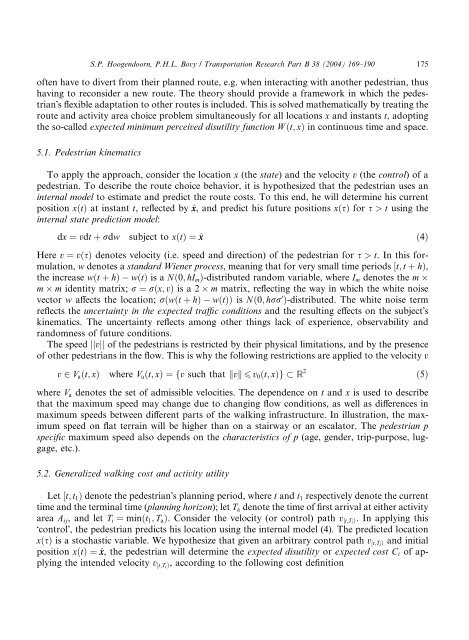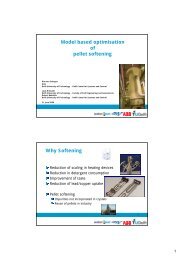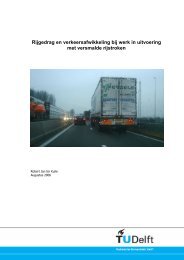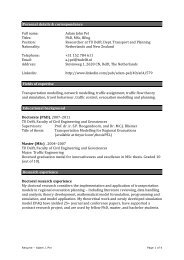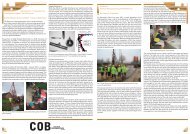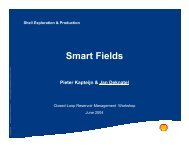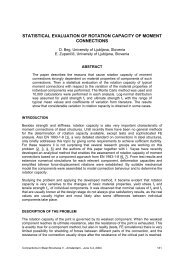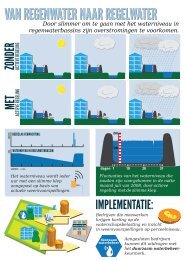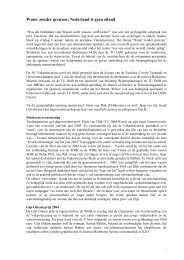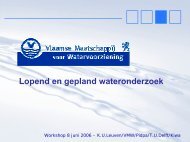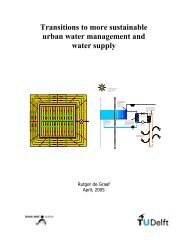Pedestrian route-choice and activity scheduling theory and models
Pedestrian route-choice and activity scheduling theory and models
Pedestrian route-choice and activity scheduling theory and models
Create successful ePaper yourself
Turn your PDF publications into a flip-book with our unique Google optimized e-Paper software.
S.P. Hoogendoorn, P.H.L. Bovy / Transportation Research Part B 38 (2004) 169–190 175<br />
often have to divert from their planned <strong>route</strong>, e.g. when interacting with another pedestrian, thus<br />
having to reconsider a new <strong>route</strong>. The <strong>theory</strong> should provide a framework in which the pedestrianÕs<br />
flexible adaptation to other <strong>route</strong>s is included. This is solved mathematically by treating the<br />
<strong>route</strong> <strong>and</strong> <strong>activity</strong> area <strong>choice</strong> problem simultaneously for all locations x <strong>and</strong> instants t, adopting<br />
the so-called expected minimum perceived disutility function W ðt; xÞ in continuous time <strong>and</strong> space.<br />
5.1. <strong>Pedestrian</strong> kinematics<br />
To apply the approach, consider the location x (the state) <strong>and</strong> the velocity v (the control) ofa<br />
pedestrian. To describe the <strong>route</strong> <strong>choice</strong> behavior, it is hypothesized that the pedestrian uses an<br />
internal model to estimate <strong>and</strong> predict the <strong>route</strong> costs. To this end, he will determine his current<br />
position xðtÞ at instant t, reflected by ^x, <strong>and</strong> predict his future positions xðsÞ for s > t using the<br />
internal state prediction model:<br />
dx ¼ vdt þ rdw subject to xðtÞ ¼^x ð4Þ<br />
Here v ¼ vðsÞ denotes velocity (i.e. speed <strong>and</strong> direction) of the pedestrian for s > t. In this formulation,<br />
w denotes a st<strong>and</strong>ard Wiener process, meaning that for very small time periods ½t; t þ hÞ,<br />
the increase wðt þ hÞ wðtÞ is a Nð0; hI m Þ-distributed r<strong>and</strong>om variable, where I m denotes the m <br />
m m identity matrix; r ¼ rðx; vÞ is a 2 m matrix, reflecting the way in which the white noise<br />
vector w affects the location; rðwðt þ hÞ wðtÞÞ is Nð0; hrr 0 Þ-distributed. The white noise term<br />
reflects the uncertainty in the expected traffic conditions <strong>and</strong> the resulting effects on the subjectÕs<br />
kinematics. The uncertainty reflects among other things lack of experience, observability <strong>and</strong><br />
r<strong>and</strong>omness of future conditions.<br />
The speed jjvjj of the pedestrians is restricted by their physical limitations, <strong>and</strong> by the presence<br />
of other pedestrians in the flow. This is why the following restrictions are applied to the velocity v<br />
v 2 V a ðt; xÞ where V a ðt; xÞ ¼fv such that kvk 6 v 0 ðt; xÞg R 2 ð5Þ<br />
where V a denotes the set of admissible velocities. The dependence on t <strong>and</strong> x is used to describe<br />
that the maximum speed may change due to changing flow conditions, as well as differences in<br />
maximum speeds between different parts of the walking infrastructure. In illustration, the maximum<br />
speed on flat terrain will be higher than on a stairway or an escalator. The pedestrian p<br />
specific maximum speed also depends on the characteristics of p (age, gender, trip-purpose, luggage,<br />
etc.).<br />
5.2. Generalized walking cost <strong>and</strong> <strong>activity</strong> utility<br />
Let ½t; t 1 Þ denote the pedestrianÕs planning period, where t <strong>and</strong> t 1 respectively denote the current<br />
time <strong>and</strong> the terminal time (planning horizon); let T a denote the time of first arrival at either <strong>activity</strong><br />
area A ij , <strong>and</strong> let T i ¼ minðt 1 ; T a Þ. Consider the velocity (or control) path v ½t;Ti Þ. In applying this<br />
ÔcontrolÕ, the pedestrian predicts his location using the internal model (4). The predicted location<br />
xðsÞ is a stochastic variable. We hypothesize that given an arbitrary control path v ½t;Ti Þ <strong>and</strong> initial<br />
position xðtÞ ¼^x, the pedestrian will determine the expected disutility or expected cost C i of applying<br />
the intended velocity v ½t;Ti Þ, according to the following cost definition


